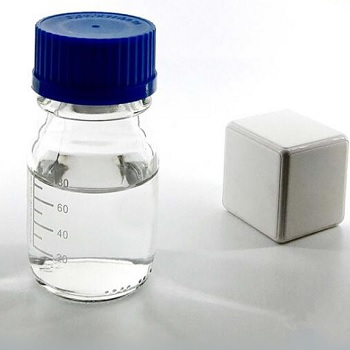2,3-Epoxypropylmethacrylat Chemische Eigenschaften,Einsatz,Produktion Methoden
ERSCHEINUNGSBILD
FARBLOSE FLüSSIGKEIT MIT CHARAKTERISTISCHEM GERUCH.
CHEMISCHE GEFAHREN
Der Stoff kann polymerisieren beim Erhitzen und unter Einfluss von Licht, Peroxiden und Basen. Reagiert heftig mit starken Säuren, starken Basen und starken Oxidationsmitteln unter Feuergefahr.
ARBEITSPLATZGRENZWERTE
TLV nicht festgelegt.
MAK nicht festgelegt.
AUFNAHMEWEGE
Aufnahme in den Körper durch Inhalation und über die Haut und durch Verschlucken .
INHALATIONSGEFAHREN
Beim Verdampfen bei 20°C kann sehr schnell eine gesundheitsschädliche Kontamination der Luft eintreten.
WIRKUNGEN BEI KURZZEITEXPOSITION
WIRKUNGEN BEI KURZZEITEXPOSITION: Die Substanz reizt stark die Augen, die Haut und die Atemwege.
WIRKUNGEN NACH WIEDERHOLTER ODER LANGZEITEXPOSITION
Wiederholter oder andauernder Kontakt kann zu Hautsensibilisierung führen.
LECKAGE
Persönliche Schutzausrüstung: Atemschutzfilter für organische Gase und Dämpfe. Ausgelaufene Flüssigkeit in abgedeckten Behältern sammeln. NICHT in die Umwelt gelangen lassen.
R-Sätze Betriebsanweisung:
R20/21/22:Gesundheitsschädlich beim Einatmen,Verschlucken und Berührung mit der Haut.
R36/38:Reizt die Augen und die Haut.
R43:Sensibilisierung durch Hautkontakt möglich.
R60:Kann die Fortpflanzungsfähigkeit beeinträchtigen.
R45:Kann Krebs erzeugen.
S-Sätze Betriebsanweisung:
S26:Bei Berührung mit den Augen sofort gründlich mit Wasser abspülen und Arzt konsultieren.
S28:Bei Berührung mit der Haut sofort abwaschen mit viel . . . (vom Hersteller anzugeben).
S45:Bei Unfall oder Unwohlsein sofort Arzt zuziehen (wenn möglich, dieses Etikett vorzeigen).
S36/37:Bei der Arbeit geeignete Schutzhandschuhe und Schutzkleidung tragen.
S53:Exposition vermeiden - vor Gebrauch besondere Anweisungen einholen.
Beschreibung
Glycidyl Methacrylate (GMA) is a clear, colorless liquid with a potent ester and fruity odor. It comprises a polymerizable methacrylate functional group on one end and a reactive epoxy group on the other. It is slightly miscible with water, soluble in most organic solvents, and has relatively low volatility. Its vapor is heavier than air. It copolymerizes readily with various functional groups, such as phenols, ketones, acids, and amines. The added epoxy group imparts durability, mechanical strength, optical transparency, and adhesiveness.
Chemische Eigenschaften
Glycidyl methacrylate (GMA) is a colorless liquid with a fruity odor. Floats on water. (USCG, 1999)

Glycidyl methacrylate is a polyfunctional monomer. It acts as an adhesion promoting crosslinking co-monomer for acrylic and vinyl resins. It is also a reactive colorless diluent. GMA is soluble in ethanol, acetone, diethyl ether, benzene.
Verwenden
Glycidyl methacrylate (GMA) is a common monomer used in the creation of epoxy resins. It is used to provide epoxy functionalization to polyolefins and other acrylate resins.
Glycidyl methacrylate is used in the production of polymer coatings and finishes, adhesives, plastics and elastomers.
Glycidyl methacrylate dextran has been reported to be used as a biocompatible hydrogel. In situ polymerization of GMA with trimethylolpropane trimethacrylate to form macroporous sorbents has also been reported. GMA may also be grafted onto polypropylene.
synthetische
Glycidyl methacrylate is produced from methacrylic acid and glycidol. Glycidol contain both epoxide and alcohol functional groups.It is an enoate ester and an epoxide. It derives from a methacrylic acid and a glycidol.
Reaktionen
Glycidyl methacrylate (GMA) is a kind of functional monomer. Its active vinyl and epoxy groups could be grafted with polyolefin and reacted with the polar groups such as amine, hydroxyl and carboxyl group, respectively. It can also undergo polymerization to form poly (glycidyl methacrylate).
Allgemeine Beschreibung
Colorless liquid with a fruity odor. Floats on water.
Air & Water Reaktionen
Flammable. Slightly water soluble.
Reaktivität anzeigen
Epoxides, such as Glycidyl methacrylate, are highly reactive. They polymerize in the presence of catalysts or when heated. These polymerization reactions can be violent. Compounds in this group react with acids, bases, and oxidizing and reducing agents. They react, possibly violently with water in the presence of acid and other catalysts.
Health Hazard
The liquid irritates eyes about as much as soap. Prolonged contact with skin produces irritation and dermatitis.
Brandgefahr
Special Hazards of Combustion Products: Irritating vapors are generated when heated
2,3-Epoxypropylmethacrylat Upstream-Materialien And Downstream Produkte
Upstream-Materialien
Downstream Produkte

